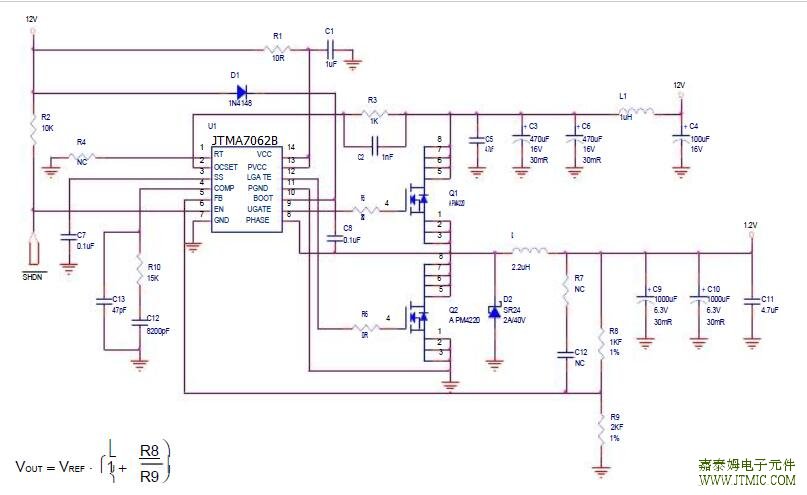五,产品封装图 (Package) RT (Pin1) This pin can adjust the switching frequency. Connect a resistor from the RT to the GND for increasing the switch- OCSET (Pin2) This pin serves two functions: a shutdown control and the setting of over current-limit threshold. Pulling this pin below 1.27V will shutdown the controller, forcing the UGATE and LGATE signals to be at 0V. A resistor (Rocset) connected between this pin and the drain of the high side MOSFET will determine the over current limit. An internal 200µA current source will flow through this resistor, creating a voltage drop, which will be com- pared with the voltage across the high side MOSFET. SS (Pin3) Connect a capacitor from the pin to the GND to set the soft-start interval of the converter. An internal 10µA current source charges this capacitor to 5.8V. The SS voltage clamps the error amplifier output, and Figure1 shows the soft-start interval. At t1, the SS voltage reaches the valley of the oscillator’s triangle wave. The PWM comparator starts to generate a PWM signal to control logic, and the COMP (Pin4) This pin is the output of the error amplifier. Add an exter-nal resistor and capacitor network to provide the loop com- pensation for the PW M converter (see Application Information). FB (Pin5) FB pin is the inverter input of the error amplifier and it receives the feedback voltage from an external resis-tive divider across the output (V OUT). The output voltage is determined by: EN (Pin6) Pull the pin higher than 2V to enable the device, and pull the pin lower than 0.8V to shutdown the device. In shutdown, the SS is discharged and the UGATE and LGATE pins are held low. The EN pin is the open-collector, and it will not be floating. GND (Pin7) Signal ground for the IC. PHASE (Pin8) This pin is connected to the source of the high-side MOSFET and is used to monitor the voltage drop across the high-side MOSFET for over-current protection. UGATE (Pin9) Connect the pin to external MOSFET, and provides the gate drive for the upper MOSFET.
BOOT (Pin 10)
Connect the pin to the external MOSFET, and provides the gate drive signal for the lower MOSFET.This pin provides the supply voltage to the high side MOSFET driver. For driving logic level N-channel MOSEFT, a bootstrap circuit can be used to create a suitable driver’s supply. PGND (Pin11) Power ground for the gate diver. Connect the lower MOSFET source to this pin. LGATE (Pin 12) PVCC (Pin13) This pin provides a supply voltage for the lower gate drive, connect it to the VCC pin in common use. VCC (Pin14) This pin provides a supply voltage for the device. When the VCC is above the rising threshold 10.4V, the device is turned on; conversely, when the VCC is below the falling threshold, the device is turned off. 六.电路原理图  七,功能概述 Output Capacitor Selection The selection of COUT is determined by the required effec-tive series resistance (ESR) and voltage rating rather than the actual capacitance requirement. Therefore, select highperformance low ESR capacitors that are intended for switching regulator applications. In some applications,multiple capacitors have to be paralled to achieve the desired ESR value. If tantalum capacitors are used, makesure they are surge tested by the manufactures. If in doubt, consult the capacitors manufacturer. Input Capacitor Selection The input capacitor is chosen based on the voltage rating and the RMS current rating. For reliable operation, select the capacitor voltage rating to be at least 1.3 times higher than the maximum input voltage. The maximum RMS current rating requirement is approximately IOUT/2 , where IOUT is the load current. During power up, the input capaci- tors have to handle large amount of surge current. If tanta-lum capacitors are used, make sure they are surge tested by the manufactures. If in doubt, consult the capacitors manufacturer.For high frequency decoupling, a ceramic capacitor be-tween 0.1µF to 1µF can be connected between the VCC and the ground pin. Inductor Selection The inductance of the inductor is determined by the out-put voltage requirement. The larger the inductance, the lower the inductor’s current ripple. This will translate into lower output ripple voltage. The ripple current and ripple voltage can be approximated by: where Fs is the switching frequency of the regulator.There is a tradeoff exists between the inductor’s ripple current and the regulator load transient response time. A smaller inductor will give the regulator a faster load tran- sient response at the expense of higher ripple current and vice versa. The maximum ripple current occurs at the maximum input voltage. A good starting point is to choose the ripple current to be approximately 30% of the maxi- mum output current. Once the inductance value has been chosen, select an inductor that is capable of carrying the required peak cur- rent without going into saturation. In some types of inductors, especially core that is make of ferrite, the ripple current will increase abruptly when it saturates. This will result in a larger output ripple voltage. Compensation The output LC filter introduces a double pole, which con-tributes with –40dB/decade gain slope and 180 degrees phase shift in the control loop. A compensation network between the COMP pin and the ground should be added. The simplest loop compensation network is shown in Figure 5. The output LC filter consists of the output inductor and output capacitors. The transfer function of the LC filter is given by: 八,相关产品
(责任编辑:oumao18) |
||||||||||||||||||||||||||||||||||||||||||||||||||||||||||||||||||||||||||||||||||||||||||||||||||||||||||||||||||||||||||||||||||||||||||||||||||||||||||||||||||||||||||||||||||||||||||||||||||||||||||||||||||||||||||||||||||||||||||||||||||||||||||||||||||||||||||||||||||||||||||||||||||||||||||||||||||||||||||||||||||||||||||||||||||||||||||||||||||||||||||||||||||||||||||||||||||||||||||||||||||||||||||||||||||||||||||||||||||||||||||||||||||||||||||||||||||||||||||||||||||||||||||||||||||||||||||||||||||||||||||||||||||||||||||||||||||||||||||||||||||||||||||||||||||||||||||||||||||||||||||||||||||||||||||||||||||||||||||||||||||||||||||||

